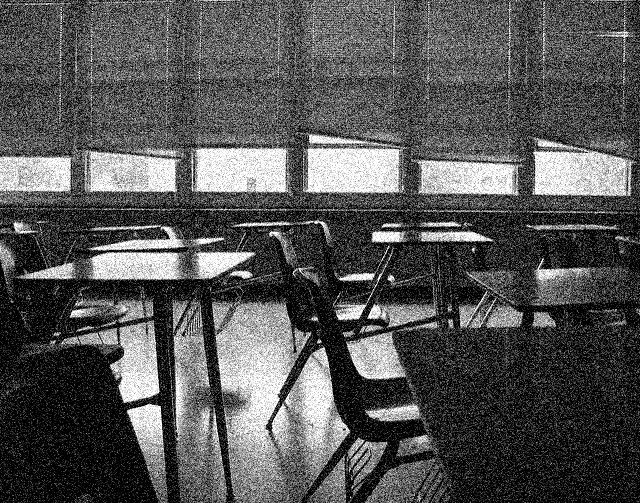A New Type of Educational Illness in Brooklyn Public Schools
In consistently "failing" schools, the competitive spirit is always present, but with an estranged character.

The children of Brooklyn’s Sumner and Marcy projects, along with hundreds of central American and Caribbean immigrants, spend their first ten school-aged years at a local magnet school just off the South Williamsburg border. Magnet schools were designed as an early “school choice” initiative to counteract segregation, promising a holistic, non-competitive atmosphere with a focus on advanced vocational skills like engineering and computer science. Yet even intense local gentrification hasn’t changed the racial makeup of the school, with less than 1% white students in attendance. Instead, parents enroll their children for its dual language classes, or because they themselves spent their first ten years there. Many simply enjoy the convenience of a school within walking distance of their home.
Within the last three decades, in the midst of extensive shifts in education policy, nearly one-third of this Brooklyn school’s student population has been declared “disabled.” Since 1990, the number of disabled children has increased nationwide by about 2 million. In New York City, one in five children have classified disabilities. While No Child Left Behind (NCLB) reduced teacher interactions and increased “data-driven” encounters within a scripted curriculum, the national Common Core Learning Standards forced teachers to push children to and beyond the developmental limits of their age. Since their inception, critics of these currents across the political spectrum recognized the cultivation of a barren and anxious competitive spirit that is educationally counterproductive, if not disastrous. Yet the intensification of globalized value production during a period spanning two major capitalist crises has animated the drive to have children “maintain America’s competitive edge,” as they were now posed to compete with students “from all across the globe for the jobs of tomorrow.”
Modern schooling as a way of reproducing, disciplining, and cultivating future workers has always responded to the demands and dynamics of the labor market. In the post-war period this largely meant developing the “human capital” skills and pseudo-autonomy that was needed for the segmentation of labor into various strata. The current curriculum’s demands for global competition, service economy social skills, and digital fluency are all impressed onto students through increasingly market-mediated competitive anxieties, cognitive-behavioral discipline and, for the growing relative surplus-population, expressed enigmatically by unconvinced teachers. The result of these ever abstract forces result in a simplification of key developmental processes for children, leading to a new constellation of symptoms and the appearance of an overall rise in educational disabilities.
Even today, as politicians frantically seek to reverse NCLB and Common Core at the state and city level, its central axioms remain in a mass of policy change, an institutionalized obsession with data, the systematic deskilling of teachers, a new curriculum, and in the trend of disability. Though some have sought to biologize the definition of disability, federal education legislation—specifically the Individuals with Disabilities Education Act (IDEA)—creates a parallel psychosocial and legal world to its medical counterpart. Students are “classified” instead of diagnosed, without a clinical psychologist’s input, yet able to receive medical services, accommodations, expensive placements, and collect social security.
As education is now shaped on a global field of competition, we can view our newly disabled students as outliers with respect to international benchmarks. As opposed to medical diagnosis, a continuity of behaviors in different settings (e.g. the home) need not apply in education-specific classification. Testing, transitions, scarcity of resources, and the demands of a new curriculum are the triggers of these school-borne illnesses, and a particular set of “behavioral concerns” are their symptoms. When symptoms manifest, teachers do not rely upon classical explanations (“This student is disruptive”) but rather speak the new language: “I just don’t have the time to work with him,” or “he needs a different setting.” Observing in the back of a crowded classroom, with its Pearson scripted and rationalized lesson plan in action, the school psychologist uses standardized CBT-style “functional behavioral analysis” worksheets which inexorably lead him to “attention seeking” as the root of most problem behaviors.
One portion of the burgeoning disabled are the “emotionally disturbed,” a category defined primarily in negative terms—an inability to learn, with no corresponding explanation according to intellectual, physical, or health factors. A separate sufficient criterion is an inability to develop interpersonal relationships with teachers or peers. Curiously, the label does not apply to those students who are “socially maladjusted,” “unless it is determined that they have an emotional disturbance” using the criteria above. Implied in this circular categorization is the recognition that therapy can and should do little to change the conditions of the “socially maladjusted.”
Educational illness elicits holding, recognition, and integration on one end of the therapy spectrum, and rote psychological discipline and coercion on the other. Mental health staff must interpret and navigate the transference of what is often the first bounded yet intimate relationship with an adult that an adolescent will experience. Informal supportive therapy while sharing a meal can provide a grounding and containing practice for the anxious, poor, and hungry. Play and recognition provide the minimal collective conditions for selfhood and autonomy, and a critical treatment for pathology in childhood. Contrarily, volumes of CBT research produce an arsenal of techniques that seek to avoid costly human relationships and focus on masking needs with compliant behaviors, wildly successful in the short term. Lab rat “operant conditioning” techniques seek to adapt the student to homogenous, fifty-minute work periods, repressing conflicts that inevitably reappear later on, yet in an obscure and intensified manner.
In our consistently “failing” school, ever threatened with “renewal,” the competitive spirit is always present yet has an estranged character. Urgency is impressed onto students through teachers, who themselves are disciplined by district administrators, teach-to-the-test schemes, and consultants via endless “professional developments.” At the same time, even in this early elementary through middle school, a sense of foreclosure towards the future is already apparent. Parents, older siblings, and the building complex transmit the realistic expectations of survival in New York City. Yet with every year the pace quickens, the curriculum gets harder, the teachers more stressed, and the disabilities spread.
In reaction to this increasing presence of competition anxiety over the years, the new type of educational illness is not externalizing or characterized by overt aggression. With respect to diagnoses, ADHD as the paragon externalizing disorder is still quite common, but prevalent now is the “inattentive” or “combined” type, which is largely internalizing, with a withdrawn presentation. Further increases are seen in the ever expanding population of children who are feared to be “on the spectrum.” The controversial yet pervasive “sensory processing disorder” also fits into the new internalizing constellation. The dynamics of these trends in presentation might be described as traditionally schizoid. A proposed common etiological factor: the complexity of the child’s psyche is reduced by an ego restricted in reaction to ethereal yet intense objective competitive anxiety and a superego whose original objects have abdicated, replaced by the behavioral modification code of consumption and separation, battening down unconscious drives along the way.
New trends in themes of fantasy life are most obvious in pictures and play for the young ones, and enactment and talk for adolescents. For these new emotionally disturbed, we observe their images of hollow or nested objects, labyrinths, layers of emptiness, dismemberment, and, of course, weapons as ornaments. Aggression and apathy do not find expression in classical symptoms but rather in forgetfulness and a lack of “executive functions.” Unlike students from middle-class schools, there is not a dilemma of success or failure dominated by sadistic impulses towards self or others, nor is there an impetus towards rebellion and separation. For the new type of educational illness, there is a disassociation that matches an entirely absent future. In their free time, the enormous pressures of social media—an online personality market—are consistent antecedents to new cases of self-harm or suicidal ideation. “Online bullying” is a strawman hot topic in the school mental health pop literature. The underlying problem is teens with weak or diffuse egos taking shelter in an unstable transitional space, with limited opportunity for expression and growth.
External to the school, post-Giuliani gentrification stymies aggression in youth culture by sterilizing the community with cops and cafes, eliminating the few determinate symbols they can subvert and play with creatively. In this context the languid lecture on competition, achievement, and meritocracy isn’t even half-believed by the teacher who gives it, let alone the student. There is literally less writing on the walls. Graffiti has slowly disappeared with Snapchat. During state tests, the disabled have double time as an accommodation on their IEPs. They spend four or five hours in quiet, complacently doodling while shaking their legs. As for the few rebels that arise, their aggression erupts with such intensity and generalization that they are quickly segregated down the school-to-prison pipeline to “restrictive settings.” Kids don’t run tough public schools anymore like the days of the Ocean Hill-Brownsville protests of 1968, but then again, neither do teachers or parents.
■
Jonathan Chabrier is a practicing school psychologist and native of Brooklyn, New York.



